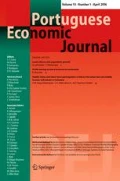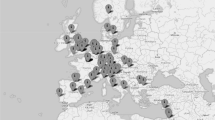Abstract
Following Hidalgo et al. (Sci Mag 317: 482–487, 2007), we use the structure of international trade to estimate a measure of “revealed relatedness” for each pair of internationally traded products, which intends to capture similarities in terms of the endowments or capabilities they use in production. Our method departs from the original one, in that we run statistical tests of equality in probabilities, instead of computing conditional probabilities. We estimate a matrix of “Revealed Relatedness Indexes” using 2005 data and we then investigate which “upscale” products in which Portugal didn’t develop comparative advantage are more related to products in which the country is currently specialized. The analysis suggests that more than 60 % of Portugal’s “upscale opportunities” lie in non-traditional sectors, such as “machinery” and “chemicals”.




Similar content being viewed by others
Notes
The approach goes beyond the traditional trade theories in that it not only accounts for the role of static endowments but also for those capabilities that are endogenous to the specialization pattern, including Marshallian external effects and learning by doing. Theoretical models accounting for a circular causation between the specialization pattern and comparative advantages (arising from industry-specific learning or from scale economies in non-tradable intermediate inputs) include Rodriguez-Clare (1996), Rodrik (1996), Matsuyama (1992), Young (1991), Lucas (1988), and Krugman (1987). Jovanovic and Nyarko (1996) build a microeconomic model whereby the individual decision to switch to a new technology depends on how transferable the knowledge accumulated in dealing with the old technology is.
It should be noted that, even using a 4-digit classification level, considerable heterogeneity remains in some product categories. For instance, behind the code “8703–Motor cars …” there are many activities that differ significantly in terms of value added. Thus, any two countries engaged in mutual trade of complementary sub-activities of this item may actually differ quite significantly in qualitative terms. Moreover, cross-border trade flows related to the fragmentation of value chains will in general double count the implied value added, giving rise to significant differences between RCA indexes computed using gross trade data relative to estimates based on value added data (Koopman et al. 2014). These are however unavoidable limitations of the dataset being used. We thank a referee for pointing out this limitation.
The estimated matrix is available from the authors upon request.
The Bonferroni correction sets the significance cut-off at α/n where n is the number of significance tests.
This criticism does not apply to Hidalgo et al. (2007). These authors mapped the product space in a two dimension plan ignoring conditional probabilities lower than a given level. In particular, they considered only 1525 relationships, out of the 750 × 750 estimated relationships.
Note that, in our framework, row sums and columns sums are not, in general, equal.
It should be noted that this measure differs slightly from the “density” measure proposed by Hausmann et al. (2007), which is given by \( \omega {\prime}_{j,c}={\displaystyle \sum_iRR{I}_{ij}{x}_{ic}}/{\displaystyle \sum_iRR{I}_{ij}} \). Thus, while we are measuring the absolute relatedness of product j to the products in which the country is specialized, Hausmann et al. (2007) measure the proportion of product j - overall relatedness to other products that is accounted by those in which the country is specialized.
References
Balassa B (1965) Trade liberalization and ‘revealed’ comparative advantage. Manch Sch Econ Soc Stud 33(2):99–123
Benjamini Y, Hochberg Y (1995) Controlling the false discovery rate: a practical and powerful approach to multiple testing. J R Stat Soc Ser B 57:289–300
Blanchard O, Portugal P (2001) What hides behind an unemployment rate: comparing Portuguese and U.S. labor markets. Am Econ Rev 91(1):187–207
Efron B (2010) Large-scale inference: empirical Bayes methods for estimation, testing, and prediction. Cambridge University Press, Cambridge
Hausmann R, Klinger B (2006) Structural transformation and patterns of comparative advantage in the product space. CID Working Paper no. 128, Center for International Development (CID) at Harvard University
Hausmann R, Klinger B (2007) The structure of the product space and the evolution of comparative advantage. CID Working Paper no. 146, Center for International Development (CID) at Harvard University
Hausmann R, Hwang J, Rodrik D (2007) What you export matters. J Econ Growth 12:1–25
Hidalgo C, Klinger B, Barabasi A, Hausmann R (2007) The product space conditions the development of nations. Sci Mag 317:482–487
Jovanovic B, Nyarko Y (1996) Learning by doing and the choice of technology. Econometrica 64(6):1299–1310
Koopman R, Wang Z, Wei S (2014) Tracing value-added and double counting in gross exports. Am Econ Rev 104(2):459–494
Krugman P (1987) The narrow moving band, the dutch disease and the competitive consequences of Mrs. Tatcher. J Dev Econ 27:41–55
Lucas R (1988) On the mechanics of economic development. J Monet Econ 22:3–42
Matsuyama K (1992) Agriculture productivity, comparative advantage and economic growth. J Econ Theory 58:317–334
Rodriguez-Clare A (1996) The division of labour and economic development. J Dev Econ 49:3–32
Rodrik D (1996) Coordination failures and government policy: a model with applications to East Asia and Eastern Europe. J Int Econ 40:1–22
Young A (1991) Learning by doing and the dynamic effects of international trade. Q J Econ 106:369–405
Acknowledgments
The authors acknowledge the editor and two anonymous referees for helpful comments and suggestions. Luis Catela Nunes acknowledges support from FCT grant UID/ECO/00124/2013.
Author information
Authors and Affiliations
Corresponding author
About this article
Cite this article
Lebre de Freitas, M., Nunes, L.C., Neves, R.C. et al. Productive experience and specialization opportunities for Portugal: an empirical assessment. Port Econ J 14, 5–30 (2015). https://doi.org/10.1007/s10258-015-0108-z
Received:
Accepted:
Published:
Issue Date:
DOI: https://doi.org/10.1007/s10258-015-0108-z








